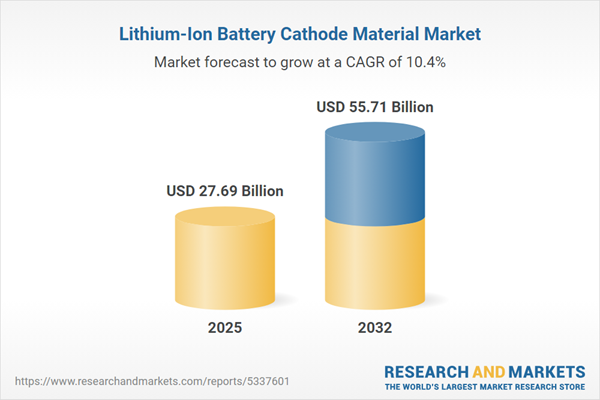Speak directly to the analyst to clarify any post sales queries you may have.
Senior executives navigating the lithium-ion battery cathode material market must adapt swiftly to regulatory shifts, evolving supply chain models, and rising sustainability expectations. This sector demands strategic foresight, agile operations, and continual innovation to sustain competitive advantage.
Market Snapshot: Lithium-Ion Battery Cathode Material Market
The lithium-ion battery cathode material market is projected to grow from USD 25.33 billion in 2024 to USD 27.69 billion in 2025, driven by a 10.35% CAGR. Continued momentum in electric vehicle manufacturing, expansion of stationary energy storage systems, and stable demand from electronics manufacturers remain the primary growth catalysts. Stakeholders are strengthening both regional and domestic supply chains while embedding sustainability frameworks into core strategies. Compliance standards are evolving, prompting organizations to implement new protocols, adopt flexible production models, and pursue innovative supply approaches. In this environment, operational resilience and strategic alignment are paramount for maintaining sector leadership and ensuring business relevance.
Scope & Segmentation: Strategic Breakdown
- Cathode Chemistry: Lithium cobalt oxide, lithium iron phosphate, lithium-rich manganese compounds, lithium nickel oxide, nickel cobalt aluminum oxide, nickel manganese cobalt oxide, and spinel-based cathodes designed to balance safety, longevity, and efficiency for differing market demands.
- Form Factor: Coin, cylindrical, pouch, and prismatic cell formats, each offering application-based adaptability across consumer, infrastructure, and industrial uses.
- Supply Source: Virgin and recycled material streams, supporting supply stability, enabling circular economy practices, and reducing exposure to raw material price volatility.
- Production Process: Co-precipitation, hydrothermal, sol-gel, solid-state, and spray pyrolysis methods, tailored to match regional and sector-specific production requirements.
- Precursor Type: Iron phosphate, various lithium salts, and advanced additives to enhance battery cycle life and operational stability.
- Surface Modification: Protective coatings and dopants such as aluminum oxide, lithium phosphate, titanium oxide, zirconium oxide, magnesium, and tungsten, engineered for durability across high-demand sectors including automation and transport.
- Application: Serving end markets including consumer electronics, electric vehicles, grid-scale energy storage, aerospace, shipping, automation, and healthcare, each subject to specific compliance conditions and operational benchmarks.
- Distribution Channel: Direct-to-customer, distributor-based, traded, contractual, and spot purchase models, providing procurement options for firms of varying size and geographic footprint.
- Geographic Coverage: Market activity spans the Americas, EMEA, and Asia-Pacific, with robust developments in the U.S., China, Germany, Japan, India, and Brazil, influenced by distinct investment climates and regulatory requirements in each region.
Key Takeaways: Senior Executive Insights
- High-nickel, low-cobalt compositions assist in mitigating raw material sourcing risks and improving cost control across supply chains.
- Particle engineering advancements and increased automation deliver increased product consistency and reliability, particularly for vehicle electrification and energy storage market needs.
- Expanding reliable regional supplier relationships enhances resilience against cross-border disruptions and logistics challenges from shifting regulatory environments.
- Selecting chemistries such as iron-phosphate and advanced nickel-rich variants supports extended lifecycle and high operational safety, critical for transport and stationary applications.
- Closed-loop recycling and adoption of digital traceability solutions help organizations meet stringent compliance benchmarks and reinforce environmental stewardship credentials.
Tariff Impact: Global Supply Chain Shifts
Adjustments to U.S. tariffs on battery precursor imports are increasing production costs and accelerating a strategic pivot toward domestic manufacturing. This environment compels firms to reassess sourcing strategies, optimize cathode composition, and enhance supply chain resilience while maintaining operational flexibility in response to international regulation changes.
Methodology & Data Sources
This research combines direct executive interviews, targeted supply chain surveys, extensive patent analytics, and cross-validated data from reputable third parties. The multi-pronged approach results in credible forecasts and offers senior planners robust insights to underpin strategic decision-making in the lithium-ion battery cathode material sector.
Why This Report Matters
- Delivers clarifying insights on technological innovation, procurement strategies, and market segmentation, supporting informed leadership decisions.
- Offers actionable frameworks and structured guidance for managing evolving regulatory and environmental demands within the lithium-ion battery landscape.
- Enables organizations to proactively address tariff shifts and recalibrate supply chains to mitigate operational risk.
Conclusion
Senior leaders will find this report essential for anticipating sector evolution, strengthening operational agility, and achieving durable positioning within the lithium-ion battery cathode material market.
Additional Product Information:
- Purchase of this report includes 1 year online access with quarterly updates.
- This report can be updated on request. Please contact our Customer Experience team using the Ask a Question widget on our website.
Table of Contents
3. Executive Summary
4. Market Overview
7. Cumulative Impact of Artificial Intelligence 2025
Companies Mentioned
The companies profiled in this Lithium-Ion Battery Cathode Material market report include:- BASF SE
- Fujitsu Limited
- AGC Inc.
- Anhui Boshi High-tech New Materials Co., Ltd.
- Arkema S.A.
- Beijing Easpring Material Technology Co., Ltd.
- BTR New Material Group Co., Ltd.
- CBAK Energy Technology, Inc.
- CHENGTUN MINING GROUP CO.LTD
- CMOC Group Limited
- Dongguan Pengjin Machinery Technology Co., Ltd
- Gotion High-tech Co., Ltd.
- Hitachi Chemical Co. Ltd
- Huayou Cobalt Co., Ltd.
- JFE Chemical Corporation
- Johnson Matthey PLC
- LG Chem Ltd.
- Mitsubishi Chemical Corporation
- Mitsui Mining & Smelting Co., Ltd.
- NEI Corporation
- Nichia Corporation
- Ningbo Shanshan Co., Ltd.
- POSCO HOLDINGS
- Shandong Gelon Lib Co., Ltd.
- South Manganese Investment Limited
- SPARKZ, Inc.
- STRATUS MATERIALS INC
- Sumitomo Metal Mining Co., Ltd.
- Targray Technology International Inc.
- Tianqi Lithium
- Toda Kogyo Corp.
- Umicore
- Varta AG
- Vision Lithium
- Wildcat Discovery Technologies
- Xinxiang Hongli Power Supply Technology Co., Ltd.
Table Information
| Report Attribute | Details |
|---|---|
| No. of Pages | 197 |
| Published | November 2025 |
| Forecast Period | 2025 - 2032 |
| Estimated Market Value ( USD | $ 27.69 Billion |
| Forecasted Market Value ( USD | $ 55.71 Billion |
| Compound Annual Growth Rate | 10.3% |
| Regions Covered | Global |
| No. of Companies Mentioned | 37 |









